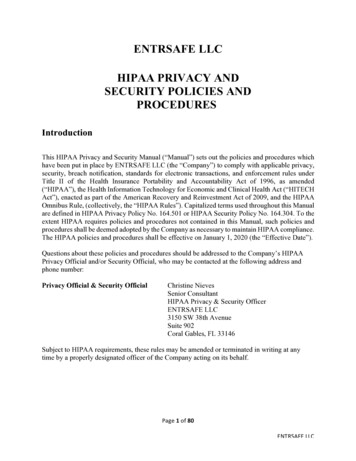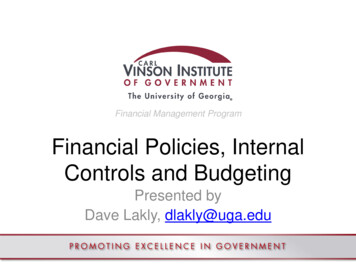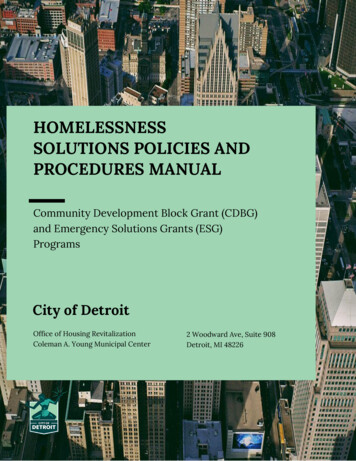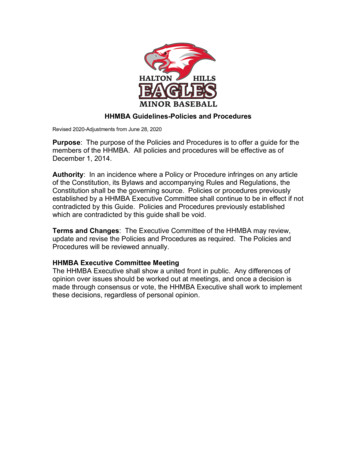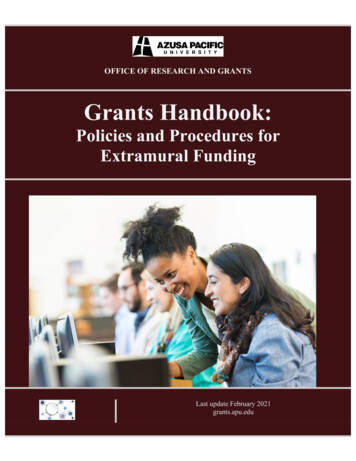
Transcription
OFFICE OF RESEARCH AND GRANTSGrants Handbook:Policies and Procedures forExtramural FundingLast update February 2021grants.apu.edu
CONTENTSGeneral Information3The Grant Cycle4Pre-Award Support4Proposal Planning and Finding Funding Opportunities6Proposal Development8Proposal Routing and Submission ProcessPost-Award Support1114Negotiating and Accepting the Award14Implementing and Monitoring Awards16Managing and Preparing Change Requests21Close Out21Appendices23Appendix I: Policy and Process for Grants Handbook Infractions23Appendix II: Roles and Responsibilities24Appendix III: Forms and Policies26Appendix IV: Proposal Routing Process28Appendix V: Direct and Indirect Costs29Appendix VI: Subrecipient Information35Appendix VII: Compliance37Appendix VIII: Procedure on Grant-Funded Personnel Hiring and Arrangement40Appendix IX: Procedures for Disclosure and Management of Conflicts of Interestin Research43Grants Lexicon47Contact Information512 Page
GENERAL INFORMATIONAPU encourages faculty and staff to seek external funding for research and programmatic projects and activitiesthat will support and enrich our institutional mission. The Office of the Provost through the Office of Researchand Grants (ORG) in collaboration with the Business Office provides this Grants Handbook to assist APUconstituents to prepare grant applications and proposals for research, service, curricular development, training,and other program operations supported by external funding.The Office of Research and Grants (ORG) promotes, supports, and celebrates research and grant opportunitiesto advance the scholarship cornerstone of Azusa Pacific University.ORG core values are: Empowering others Serving those we work with Helping others make connections Embracing and promoting accountabilityThe Grants Handbook outlines policies and procedures relating to APU faculty and staff involved in sponsoredresearch and programs at APU. In the event of any inconsistency or conflict, applicable law supersedesuniversity policies and university policies supersede college, department, or lower unit bylaws, policies, orguidelines. Externally funded projects are subject to APU policiesand funders’ grant policies, provided the funders’ policies are in thegrant agreement or other contract(s) and consistent with APUpolicies.The Policy and Process for Grants Handbook Infractions is in effectand included in Appendix I.Resources for APU faculty, academic administrators, and staff tolearn more about grant submission and management include theAPU Grants website, www.apu.edu/researchandgrants/ and theORG google site, grants.apu.edu.grants.apu.edu3 Page
THE GRANT CYCLEPost-AwardPre-AwardConceptualizeIdeaConclude ProjectClose OutImplementProject andManageIdentify FundingOpportunityGrant Writingand ApplicationDevelopmentNegotiate andAccept AwardRoute andSubmit ProposalPRE-AWARD SUPPORTAn important goal of the Office of Research and Grants (ORG) is to help in the process of securing externalfunding for research, equipment acquisition, professional and program development, and service projects. Thepre-award team (director of Sponsored Research, other pre-award staff) guides faculty, administration, andother full-time employees of APU in identifying appropriate funding sources and provides guidance for grantapplications submissions to federal and state departments, foundations and nonprofit agencies, professional andscholarly organizations, private corporations, and other sponsors offering funding opportunities for privatehigher education institutions. The director of Sponsored Research reviews and guides grant applications throughthe APU routing system and coordinates timely submission of proposals to funding agencies. These supportservices assume those pursuing extramural funding are doing so in ways that benefit colleges and schools perthe agenda set forth by University leadership. Accordingly, prospective grant proposals should be initiated inconsultation with chairs, deans, or other leaders at the beginning stages.Project Director/Principal Investigator (PD/PI). To ensure sponsored research and programs are conductedby those with requisite preparation and that there are appropriate institutional relationships with those pursuingexternal funding, ORG typically supports proposals for projects coming from PD/PIs who are full-time APU4 Page
faculty or staff, part-time APU faculty, or APU senior adjuncts on part-time contracts. On occasion, otheradjunct faculty may be supported by special permission upon recommendation of the dean and approval of theORG executive director.Exceptions to the normal PD/PI guidelines are initiated by prospective PD/PIs providing to their dean:1. Name of person requesting PD/PI status and relationship to department/college/school.2. Title of project and brief description (one paragraph). If no formal title, provide a brief descriptive ofintended activities.3. Name of funding agency, if known. If not known, indicate types of funders to be sought out.4. Approximate dates during which the project will take place if funded.If in favor, the dean’s office forwards the above to the ORG executive director along with:1. Compelling reason for an exemption to the PD/PI policy.2. Likelihood proposed PD/PI will continue current or similar association with the University throughoutexpected dates of project.3. Brief assessment of department/college/school’s willingness and ability to provide normal grant supportservices offered to full-time faculty and staff who receive external awards.Once the ORG executive director receives the above information and communicates approval of an exception inwriting back to the dean, the prospective PD/PI can access ORG grant-support services as outlined in thishandbook. Ensuing activities on grant proposals would come under guidelines cited in the Pre-Award Servicessection of this handbook, including standard routing expectations.Pre-Award Services. Once a funding opportunity has been identified, the pre-award team will provide supportwith the following:-Discuss and analyze the funding opportunity announcement with the PD/PI and identify APU internalrouting and sponsor deadlines, with the expectation that the PD/PI has the support of Universityleadership for the prospective proposal.Provide access to samples, templates, and other resources for sections of the application, when availableProvide guidance and feedback on developing the budget and budget narrativeProvide feedback on the proposal narrative, specifically the opportunity match, the applicationrequirements, and editorial suggestions as neededGuide the APU online grant routing process and coordinate application updates5 Page
-Coordinate submission of completed and approved grant application to sponsor.Develop idea anddiscuss withcolleagues/mentors/APU leadershipFill out forms andget chair and deanapprovalSubmit applicationand forms to ORGfor APU routingDetermine possiblefunding sourcesContinue to discusswith and get inputfrom chair and deanIncorporatefeedback from APUrouting processConnect with ORG,plan proposaldevelopment,get helpDraft application,get feedback,updateSubmission ofapplicationORG makes training available to faculty, administrators, staff, departments, and schools by hosting workshopson finding funding opportunities, proposal development, grant writing, grant budgeting, and other topics.Additionally, ORG works with faculty individually upon request to identify funding opportunities. In support ofthe grant effort, ORG issues periodic grant funding alerts that identify recently announced fundingopportunities. Grant resources and forms are posted on the ORG webpages (www.apu.edu/researchandgrants)and ORG google site (grants.apu.edu).PROPOSAL PLANNING AND FINDING FUNDING OPPORTUNITIESAll grant and contract applications require APU internal review and approval prior to submission by theUniversity to the funding agency. ORG guides the grant proposal through APU’s routing and approval processas described in Appendix IV. APU faculty, administrators, or staff are not authorized to solicit grants or anytype of external funding on behalf of the university without prior approval. Even though procedurally, the dean(or equivalent) is required to review and sign-off during the ten-day grant routing (see below), ideas leading toextramural funding applications are expected to have buy-in, support, and input from APU leadership, i.e.,chairs, deans, and key directors, early in the process of developing a proposal. It is important that grantproposals reflect institutional, college, and department priorities.Complete proposals should be submitted to ORG at least ten (10) business days before the sponsor deadline.At that time, the proposal will be submitted for grant routing in Cayuse SP, an online platform(apu.cayuse424.com) that facilitates the approval process and ensures a timely transfer to post-award in theevent the grant is funded.The ORG pre-award team will be available to meet with PD/PIs as needed before the internal APU/ORGsubmission deadline to coordinate the grant application elements and to clarify commitments by ORG andexpectations from the PD/PIs during the final routing process. Also, Appendix II includes information on thetypical Roles and Responsibilities assumed by different parties.If a memorandum of understanding (MOU), subagreement, or subcontract is required to be submitted with thegrant proposal, additional time (up to additional two weeks) may be required for APU’s legal counsel's review6 Page
and approval of the documents. Per federal regulations, subawards and subcontracts also require a subrecipientrisk analysis done in the pre-award phase.Written requests for an exception to the ten business day deadline may be considered in rare cases. Requestsmay be emailed to the director of Sponsored Research.Submitting a protocol application to the APU Institutional Review Board (IRB) is an important component forresearch that involves human subjects. Similarly, APU Institutional Animal Care and Use Committee (IACUC)review and approval are needed if the project includes research with animals. Compliance reviews take time;PD/PIs should plan on communicating with the IRB/IACUC coordinator as soon as they have an idea of theresearch design. Most proposals will not need review and approval by IRB/IACUC before being submitted.However, draft protocols should be available in the event the project is funded as funding is often conditionedby IRB/IACUC approvals being in place. Information on compliance aspects are included in Appendix VII.TYPES OF PROPOSALS AND FUNDING AGREEMENTS/CONTRACTSA proposal is a request for financial support for a research project or training program. The proposals (fundingrequests) are classified as follows: Solicited Proposal: This proposal is submitted in response to a request (Request for Proposal: RFP orRequest for Application - RFA) by a funding agency for research, training or program grants. Unsolicited Proposal: An unsolicited proposal is a proposal on a subject of interest to the facultymember who makes it, which the targeted funding agency may find of interest as well because it is on atopic that might be deemed as priority. Pre-Proposal: In some instances the funding agencies require an initial simpler proposal and if selected,the institution will be invited to submit a full proposal. Other terms used for this type of submission(especially for foundation grants) are: Letter of Inquiry Intent (LOI), Phase I application, OnlineFunding Inquiry. Renewal: This type of submission is usually a competing renewal for additional funding for a projectthat is currently funded but the period of performance is ending. Competing renewals generally includenew work based on the results of the existing grant (subject to peer review). Resubmission: This is usually a proposal that has been reviewed before. The updated application shouldinclude revisions in response to critical comments from initial reviewers. Revision: A revision is a request to an agency for additional support for an existing project to expandthe project’s scope or to meet unforeseen expenses. A revision may be submitted to request support for asignificant expansion or a project’s scope or research protocol. An administrative revision, also knownas “supplement”, is a request for additional funding to cover the increased costs that are within the scopeof the approved application (on the condition that the new costs were not foreseen when the new orcompeting renewal application was submitted). Continuation: This is a non-competing request for additional funding. The application is not subject topeer review.Grants, contracts, cooperative agreements, and gifts are the major types of extramural funds that the universitycan acquire. The funding proposals that are generally awarded after a competitive review process, also knownas Sponsored Projects, are subject to routing through APU Office of Research and Grants. The following areincluded: Grant. This is the instrument for providing support for a specified purpose initiated by the applicant thatfalls within the guidelines and priorities of the funding agency. Grants are defined as funding providedin exchange for the recipient performing a specified activity (scope of work) within a certain amount oftime, such as conducting a program, research project, or training project. A sponsored grant (often just7 Page
referred to as grant) is typically formalized in a written agreement that is legally binding with regard tobudgetary restrictions, agreements for cost-sharing, reporting, and other stipulations. Extramuralsponsors include federal, state and local agencies, foundations, other nonprofits, and corporations. Contract. This is the instrument by which entities/recipient institutions are considered acontractor/vendor when they provide goods and services within normal business operations and operatein a competitive environment. Contracts are defined as funding based on specific deliverables andmilestones being met and guide how the contracting parties will interact with each other. Contracts areusually designed to benefit the sponsor. Cooperative Agreement. This is an undertaking in which the program, research or training project isjointly administered by the sponsor/funding agency and the recipient institution. This mechanism isdistinguished from a grant in that it provides for substantial involvement between the federal awardingagency or pass-through entity and the non-Federal entity in carrying out the activity laid out in thefederal award. Cooperative agreements are defined as legal instruments of financial assistance between afederal agency and a non-federal entity with the expectation of substantial involvement from the federalagency in carrying out the project scope of work.A gift/donation is a unilateral transfer of money, property, or other assets from a donor to the recipient, usuallyhas fewer constraints than a sponsored program/grant. The gifts and donations are processed through the Officeof University Advancement and they are outside the purview of this handbook. If unclear on the type of fundingrequest, PD/PIs should contact the Office of Research and Grants to discuss and clarify whether the proposalwill result in a sponsored program/grant, contract, or gift.A proposal is a request for financial support for a research or program/training grant. The proposals can besolicited or unsolicited, new applications, renewals or resubmissions, and so on. It is important to correctlyidentify the types of proposals.PLANNING AND DEVELOPING THE IDEAPlanning is the key to attracting financial support for a project as the most commonly cited reason for notwriting a proposal is the lack of time. A competitive proposal may take several months to plan, develop, andsubmit to a funding source. The key to securing funding is to begin planning well in advance of the submissiondeadline because successful proposals are typically those that are carefully planned and written. The followingthree steps will assist in this process:Step One: Take a vague idea and identify a specific problem or need associated with it. Funding sources want tohelp solve problems, not finance the chasing of ideas. Next, objectives should be defined. It is important tofocus on the product, the end result or what it will accomplish, rather than on a need such as equipment or time.Activities should be clearly outlined. PD/PIs should consult with chair, dean, or other persons in supervisoryroles to ensure the idea promotes the direction that APU leadership has set.Step Two: Seek constructive criticism from colleagues, mentors or faculty in other disciplines. Constructivecriticism often indicates ways the project and its presentation can be strengthened. Establishing professionalcollaborations often increase the number of sources for support.Step Three: The idea should be transferred into a tangible, fundable project. Goals should be broken down intoconcrete objectives and corresponding activities. A clear timeline and reasonable budget that show the projectwas thought through increase the chances of the project being funded.Following are things to consider during the planning process: What is the purpose/need and who will benefit from the project? What are the goals and activities and how much will it cost? What are possible funding agencies/sponsors?8 Page
When is funding needed? (6-12 months before the start is reasonable)Will this project be done independently or in collaboration?Are matching funds from University or other sources necessary?FINDING FUNDING OPPORTUNITIESORG works with PD/PIs to match research and program ideas to potential funding sources. APU subscribes tofunding opportunities databases such as Pivot (pivot.proquest.com). ORG provides tools, training and assistsfaculty, staff and students in accessing Pivot (Quick Start guide is available at grants.apu.edu/finding-funding).ORG also provides guidance to PD/PIs on narrowing the search requests and helping to identify viable fundingsources. In support of finding funding opportunities, ORG publishes a periodical Grant Funding Alert atgrants.apu.edu/finding-funding.The following aspects should be considered when searching for funding opportunities: match (topic, team,budget, and organizational), eligibility, funding conditions. It is also helpful to contact the funding agency toverify the match, eliminate any lack of clarity, and establish rapport with the program officers. ORG can alsocommunicate with the funding agency on behalf of the project team upon mutual agreement between the PD/PIand ORG pre-award team.PROPOSAL DEVELOPMENTWRITING THE PROPOSALThe project narrative should be written such that someone unfamiliar with the proposed project/program canobtain a complete picture of what it plans to accomplish, how it will be accomplished, how it will be evaluated,how much it will cost, how long it will take to accomplish the goals and objectives, and what benefits it willprovide. Grant reviewers are often not familiar with the specific academic areas, thus narratives should bewritten for intelligent, but uninformed, readers.While PD/PIs are expected to write the grant proposals, the ORG pre-award team is committed to providingfeedback on the grant narrative and supporting documentation with the scope to strengthen the application andincrease chances of success. Grant writing resources and training are available on the ORG google site(grants.apu.edu).DEVELOPING THE BUDGETThe majority of grant applications submitted to an external sponsor require a budget explaining the intended useof the funds. A well-planned budget is essential to enhancing the quality of a proposal. If the proposal issuccessfully funded, the budget will become the project financial plan.The OMB Uniform Guidance (2 CFR Part 200) streamlines and consolidates federal requirements for receivingand using federal awards. It also clarifies costs principles and audit requirements for federal awards. Theuniversity will apply the OMB Uniform Guidance consistently for all awards. When preparing a budgetinvolving federal government grants, keep in mind the government uses uniform procedures in dealing with costanalysis, such as consultant fees, international costs, per diem, and travel. Foundations have more freedom inwhat projects they fund and how they fund them, but must meet the standards set by the Internal RevenueService to maintain their tax-exempt status. Most sponsors (federal, state, or private) have well developed9 Page
budget guidelines which should be analyzed before starting work on the project budget. The guidelines couldinclude significant details to costs that are allowable or non-allowable, but they could also contain informationregarding limitations on budget amounts, percentages, payments, and so on. Only projects closely following theguidelines will have a chance to be funded.Besides the sponsors’ guidelines, all PD/PI should take into consideration the APU policies and guidelineswhen developing a budget. Budget templates that adhere to APU guidelines and also align with federal andother types of grant submissions are posted on the ORG site (grants.apu.edu/proposal-development).Direct CostsThe direct costs are expenditures that are directly linked with the project or a specific activity in the project. Thefollowing are highlights related to direct costs. This section is not all inclusive and Appendix V should bereviewed for more details: Personnel costs include salaries for new and existing positions, salary supplements (including summersalary), faculty buyout (also known as course release), and fringe benefits. A reasonable workload should be maintained to carry out university appointments and all sponsoredresearch projects. The Policy on Faculty Compensation from Grants (see list of policies in Appendix III)includes information on institutional salary cap (137.5%), faculty buyout calculation, and otherparticulars, and it should inform the budget decisions. PD/PIs should explicitly state in the Budgetsection of the routing application (in Cayuse SP) whether grant funding is intended to underwrite currentsalary or if it will be considered as overload. If the grant application includes faculty buyout or the assignment of units to research, this should beclearly articulated and approved by the faculty member’s department chair and dean using the Currentand Pending Support form (available at grants.apu.edu/proposal-routing). Similarly, the time and effortcontributions of additional faculty members (e.g. statisticians, consultants, translators, etc.) and staffcontributing to the project should be explained in the budget justification portion of the grantapplication. Fringe benefits rates are estimated at 26% for full time positions and 10% for part time positions. Therate should also be applied when calculating faculty buyout. Travel under all grants should be calculated in accordance with the APU Travel and Business ExpensePolicy (HR Total Access under APU Forms & Policies). Rates for mileage, phone reimbursement, and some other items are assessed annually, and ORG canprovide these updates for use in budget estimations. Equipment and software are subject to APU Information and Media Technology (IMT) approval. ORGcan provide the appropriate rate for use in budget estimations. Research subjects’ incentives should be modest (check rates used in similar studies) and should becleared with APU's Human Resources department.Allowability of costs should be determined early in the process to avoid the need to adjust the budget. For moredetails regarding the direct and indirect costs, please refer to Appendix V.Indirect CostsThe university has a federally negotiated indirect cost (F&A) rate of 30% applicable to modified total directcosts (MTDC) base. Unless the sponsor has established a lower indirect cost rate or does not allow any indirectcost charge, all budget proposals should include the indirect cost charge of 30% MTDC. Rare exceptions ofindirect costs partial or total waiver may be allowed by request. To request a waiver, PD/PIs need to submit anIndirect Costs Waiver form as part of the online routing process. This form is available on the ORG google site10 Page
(grants.apu.edu/proposal-routing). Requests will be evaluated by the ORG executive director. Please refer to thedirect costs and indirect costs section in the Appendix V for additional details.Cost-Share, Matching Funds, and In-Kind ContributionsInstitutional contributions (cost-share, matching funds, in-kind contributions) should be included in grantbudgets only if the funding agency requires those contributions. Voluntary committed cost-sharing is notencouraged or expected and it usually does not influence the merit of an application (OMB 200.306). If costshare contributions are included, explicit information, including department fund number, should be provided inthe Budget section of the Cayuse SP routing application.Cost-sharing is defined as any project costs that are not reimbursed by the sponsor to support the scope of workdefined by the funding agency (federal or non-federal). As specified in the OMB Uniform Guidance (OMB§200.306), voluntary committed cost-sharing is not expected under federal research proposals, and it is not to beused as a factor in the review of applications. Cost-sharing can be funded by APU or, in some cases, a thirdparty resource. In either case, details related to expected amounts and accounts to charge must be listed in therouting application and clear communication (letters of support in certain circumstances) from thedepartment/school should be provided to justify the claim.Matching funds are occasionally required as a condition of the award. A synonym term for matching funds is“mandatory cost-sharing”. The matching funds must be explicitly stated in the proposal budget sheet and mustreceive prior clearance from the dean and the Business Office. The matching funds must be documented in preaward similar to the cost-sharing (see description in the paragraph above).In-kind contributions represent time, space and operational expenses incurred by the department or theUniversity in support of the proposed project. These funds should be reasonably quantified.Funding RestrictionsState grants limitations: California state agencies receive part of their funding from the state legislature whichresponds to societal needs in education, public health, and social services. APU is able to accept awards up to,but not including, 100,000 per fiscal year per state agency in California.PROPOSAL ROUTING AND SUBMISSION PROCESSAll grant applications are required to go through the APU routing process duringwhich the application passes through review by pertinent University offices andsenior administration. The grant routing process is facilitated by the director ofSponsored Research and the pre-award team.ROUTING THE PROPOSALThe routing process takes place through the Cayuse Research Suite, specificallyCayuse SP, an online platform available to all APU employees through single signon at apu.cayuse424.com. The PD/PI or their designated department administratorshould start the routing proposal in a timely manner to allow approvals to comethrough. Details on how to create and complete a proposal in Cayuse SP areprovided on the ORG google site.The proposal should be submitted for routing and dean approval at least ten (10)business days prior to the grant submission deadline (a.k.a. sponsor deadline).Besides the proposal attachments, there are additional forms required at the time ofCayuse SPProposals QuickStart Guide Link11 Page
routing submission depending on the particular proposal. The table below outlines special circumstances andforms required at routing submission.Circumstance prompting additional formsFormRequiredProject involves researchPotential Conflict of Interest FormYesFaculty salary/course release is included inthe project budgetCurrent and Pending Support Form - FacultyYesStaff salary/buyout is included in the projectbudgetCurrent and Pending Support Form - StaffYesSubaward to another institution is includedas part of the budgetSubrecipient Information FormYesIndirect cost rate - PD/PI asking to use alower or no IDC than sponsor allowed rateIndirect Cost (IDC) Waiver/ReductionYesNIH grant submissionNIH PI Assurance CertificationYesAs mentioned in Appendix III, all forms are available online at www.apu.edu/researchandgrants/grants/ l-routing.A more detailed look at the APU grant routing process is included in Appendix IV. The Policy and Process forGrants Handbook Infractions is also in effect and it is included in Appendix I.Subrecipient InformationSubaward recipient candidates will be asked to submit the Subrecipient Information form, the scope of work,the budget, the budget justification, and biosketches for their project (form available online atwww.apu.edu/researchandgrants/grants/). If an agreement contract or MOU are required at the time of theapplication submission, the Office of General Counsel will conduct a legal review of the proposed contractterms and the authorizing organization representative, ORG, and PD/PIs must review and approve the scope ofwork and the budget. Review of legal documents could add extra days to the grant routing process, hence thepotential subrecipients should be contacted well in advance.As part of the routing process, the director of Sponsored Research will conduct a subrecipient risk analysis inaccordance with the OMB Uniform Guidance 2 CFR Part 200.205. More information on the procedures relatedto subawards and subrecipients are attached in Appendix VI: Subrecipient Information. After determining thelevel of risk associated with the subrecipient, the director of Sponsored Research will communicate with
The Grants Handbook outlines policies and procedures relating to APU faculty and staff involved in sponsored research and programs at APU. In the event of any inconsistency or conflict, applicable law supersedes university policies and university policies supersede college, department, or lower unit bylaws, policies, or guidelines.







